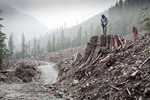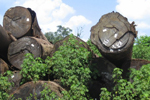The wax palm can be harvested sustainably with just a few management restrictions, according to a new study in mongabay.com’s open access journal Tropical Conservation Science (TCS). Found only in the Peruvian and Ecuadorian Andes, the leaves of the wax palm (Ceroxylon echinulatum) are used to make Easter handicrafts. But the practice has caused fears that the species, which is currently categorized as Vulnerable by the IUCN Red List, is being overexploited.
“The possible impact of leaf harvest on the survival of wax palm populations has raised questions about whether to ban such harvests or to manage the resource,” the researchers write. Scientists fear that cutting leaves from the wax palm may make the plants less able to survive. Such concerns have led the Ecuadorian government to ban the practice completely.
However, by mimicking harvesting practices over two years, the TCS study found that wax palm leaf cutting did not inhibit future leaf growth or the appearance of new leaves. In fact, some plants actually sped up growth in response to cutting.
“The study showed that the ecologically sustainable harvesting potential of [the wax palm] is high,” the researchers write. “However, if the individual is subject to annual cropping, it is unknown whether this potential for recovery can be sustained over the years.”
The scientists say their finding should push the government of Ecuador to overturn the ban on harvesting wax palm leaves, especially as the ban has had unforeseen impacts.
“This public policy has affected the income of poor villagers during Easter Celebration and favored the replacement of wax palm natural stands with pastures,” they write.
But to keep harvesting sustainable, the researchers say harvesters should not cut adjacent leaves and should limit how many leaves are cut from each palm.
“An appropriate management strategy would be to divide the population of young individuals with nine or more leaf numbers in the crown into different quadrants of rotational, biennial and monitored cropping,” they write.
CITATION: Duarte, N. and Montúfar, R. 2012. Effect of leaf harvest on wax palm (Ceroxylon echinulatum Galeano) growth, and implications for sustainable management in Ecuador. Tropical Conservation Science Vol. 5(3):340-351.
Related articles
Extremely rare plant region left unprotected in the Yucatan Peninsula
(09/17/2012) For the first time, scientists have identified the areas of the Yucatan Peninsula that hold the highest concentrations of endangered woody plants, which includes trees, shrubs, and lianas. In doing so they uncovered four key regions, but also noted that the region with the highest concentration of extremely rare plants was left unprotected, according to a new paper in mongabay.com’s open access journal Tropical Conservation Science.
Rodent robbers fill role of mega mammals, help spread tropical trees
(08/07/2012) In order to disperse their seeds, large-fruited tropical trees probably relied on massive mammals that roamed the earth over 10,000 years ago. But with giants such as the mastodon now extinct, thieving rodents—who continually excavate and rebury others’ seeds—may be filling their role, according to a new study in the Proceedings of the National Academy of Sciences (PNAS).
3-D laser mapping shows elephants have big impact on trees
(08/06/2012) Scientists have long known that African elephants (Loxodonta africana) are talented tree-topplers, able to take down even large trees in order to gobble out-of-reach leaves. However the extent of his behavior across a large area has been difficult to quantify. But a new study in Ecology Letters has used a bird’s-eye view—with 3-D—of Kruger National Park in South Africa to determine the impact of elephants on trees.
Saving ‘Avatar Grove’: the battle to preserve old-growth forests in British Columbia

(07/23/2012) A picture is worth a thousand words: this common adage comes instantly to mind when viewing T.J. Watt’s unforgettable photos of lost trees. For years, Watt has been photographing the beauty of Vancouver Island’s ancient temperate rainforests, and documenting their loss to clearcut logging. The photographer and environmental activist recently helped co-found the Ancient Forest Alliance (AFA), a group devoted to saving the island’s and British Columbia’s (BC) last old-growth while working with the logging industry to adopt sustainable practices. This February the organization succeeded in saving Avatar Grove—which was only discovered in 2009—from being clearcut. The grove, a rare stand of massive and ancient trees named after the popular eco science-fiction movie, has become a popular tourist destination, providing a new economic incentive for communities to protect rather than cut Canada’s last great forests.
Experts: sustainable logging in rainforests impossible

(07/19/2012) Industrial logging in primary tropical forests that is both sustainable and profitable is impossible, argues a new study in Bioscience, which finds that the ecology of tropical hardwoods makes logging with truly sustainable practices not only impractical, but completely unprofitable. Given this, the researchers recommend industrial logging subsidies be dropped from the UN’s Reducing Emissions from Deforestation and Forest Degradation (REDD+) program. The study, which adds to the growing debate about the role of logging in tropical forests, counters recent research making the case that well-managed logging in old-growth rainforests could provide a “middle way” between conservation and outright conversion of forests to monocultures or pasture.